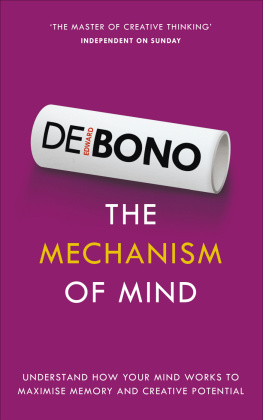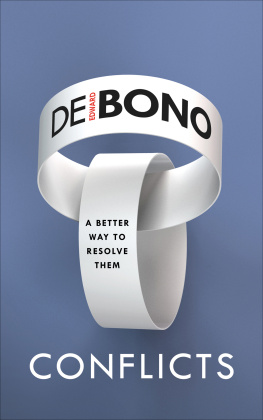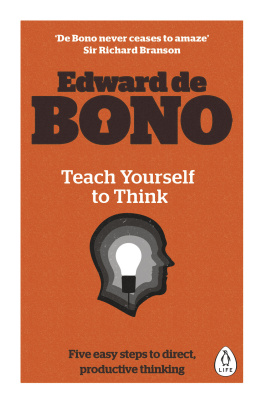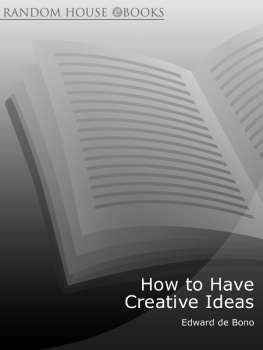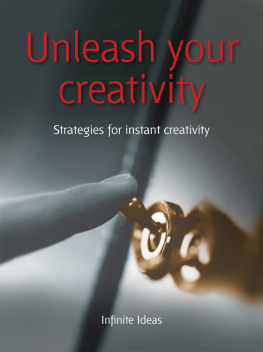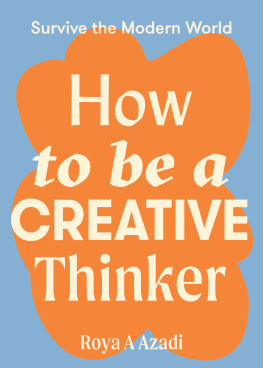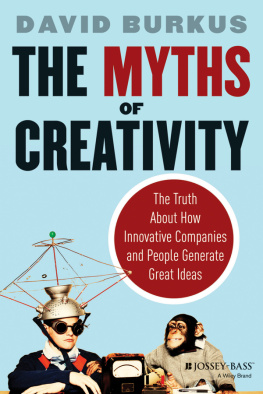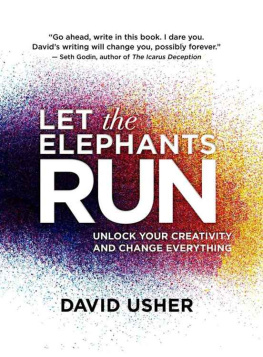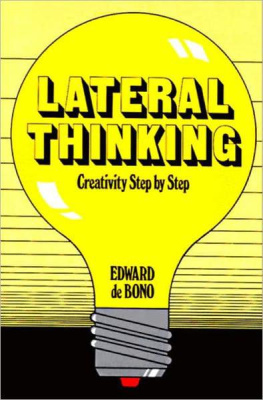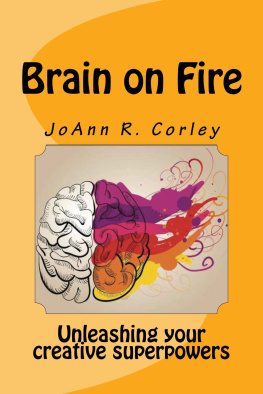Contents
Also by Edward de Bono from Vermilion:
How to Have a Beautiful Mind
The Six Value Medals
H+ (Plus) A New Religion?
How to Have Creative Ideas
Six Frames for Thinking about Information

This ebook is copyright material and must not be copied, reproduced, transferred, distributed, leased, licensed or publicly performed or used in any way except as specifically permitted in writing by the publishers, as allowed under the terms and conditions under which it was purchased or as strictly permitted by applicable copyright law. Any unauthorized distribution or use of this text may be a direct infringement of the authors and publishers rights and those responsible may be liable in law accordingly.
Version 1.0
Epub ISBN 9781473528031
www.randomhouse.co.uk
1 3 5 7 9 10 8 6 4 2
Vermilion, an imprint of Ebury Publishing,
20 Vauxhall Bridge Road,
London SW1V 2SA
Vermilion is part of the Penguin Random House group of companies whose addresses can be found at global.penguinrandomhouse.com

Copyright IP Development Corporation 1992
Edward de Bono has asserted his right to be identified as the author of this Work in accordance with the Copyright, Designs and Patents Act 1988
Published with permission from de Bono Global Pty Ltd www.debono.com
This edition first published by Vermilion in 2015
First published in the United States by HarperCollins in 1993
www.eburypublishing.co.uk
A CIP catalogue record for this book is available from the British Library
ISBN 9780091939700
About the Book
TO BE THE BEST, FOCUS ON YOUR MOST VALUABLE ASSET: YOUR MIND
In a fast-paced world the way to stay ahead is to come up with the best ideas and know how to apply them. Creative genius Edward de Bono shows you how in this thought-provoking and empowering book.
- Be creative under pressure with de Bonos step-by-step approach
- Add value to your ideas and turn them into financial assets
- Boost your creativity with lateral thinking
- Break free from old ways of thinking with creative challenging
About the Author
Edward de Bono is the leading authority in the field of creative thinking and originator of the term lateral thinking and the Six Thinking Hats. Highly regarded internationally, his instruction has been sought by governments, schools, and leading corporations around the world.
De Bonos thinking methods provide practical, creative tools to make it possible for anyone not just people considered arty to be creative on demand. These are based on an understanding of the logic of the brains self-organizing information system, which forms asymmetric patterns. This is why creative thinking can be seen as a formal and deliberate skill and not a mysterious talent. De Bonos system of lateral thinking is so powerful that the use of just one of his methods produced 21,000 ideas in a single afternoon at a workshop with a steel company.
In the Middle Ages the influence of the Church gave rise to good thinking for finding the truth, which in turn served us well in science. Edward de Bono believes this is ebne (excellent but not enough). Culturally, we have never developed thinking for creating value but it is now time we treated it much more seriously. As part of this initiative Edward de Bono has taught thinking directly in schools and his methods are in use in thousands of schools worldwide. Research has shown improvement in all subjects, increased employment and much reduced criminal behaviour.
Edward de Bono holds an MD (Malta), MA (Oxford), DPhil (Oxford), PhD (Cambridge), and Ddes (RMIT). He has had faculty appointments at the universities of Oxford, Cambridge, London and Harvard and was a Rhodes Scholar at Oxford. He has written 83 books in 42 languages in the field of creativity and thinking, including the global bestsellers Six Thinking Hats and Lateral Thinking.
IN PRAISE OF EDWARD DE BONO
Edward doesnt just think. He is a one-man global industry, whose work is gospel in government, universities, schools, corporates and even prisons all over the world Times 2
Edward de Bono is a toolmaker, his tools have been fashioned for thinking, to make more of the mind Peter Gabriel
De Bonos work may be the best thing going in the world today George Gallup, originator of the Gallup Poll
The guru of clear thining Marketing Week
PRAISE FOR HOW TO HAVE A BEAUTIFUL MIND
Mercifully free of the trite techniques offered by many publications promising to save us from social awkwardness, the book succeeds in doing just that Independent on Sunday
A clever, instructive guide... Highly recommended The Good Book Guide
PRAISE FOR HOW TO HAVE CREATIVE IDEAS
Good fun, stimulating good thinking Times Educational Supplement
A thought-provoking and thought-improving book... Simple, practical and great fun Management Today
It is simple, practical and fun and a necessary read for anyone who wants to have great ideas Business Executive
INTRODUCTION
WHY DO WE NEED THIS BOOK?
If I were to sit down and say to myself, I need a new idea here
[insert actual need area], what should I do?
I could do research and try to work out a new idea logically.
I could borrow or steal an idea used by someone else.
I could sit and twiddle my thumbs and hope for inspiration.
I could ask a creative person to produce an idea for me.
I could hastily convene a brainstorming group.
Or I could quietly and systematically apply a deliberate technique of lateral thinking (such as the random word technique), and in 10 to 20 seconds I should have some new ideas.
It is 47 years since I started working in the field of creative thinking. It is now time to tidy up and to bring things up to date. It is time to clarify and restate various techniques that have been borrowed and weakened in the process. It is time to apply the huge wealth of experience that has accumulated in that time, during which I have taught creative thinking in many countries and across different cultures to business, education, government, and other parts of society.
What has happened over these last 47 years in this important field? In some ways a lot has happened and in other ways very little.
In 1969 I wrote a book with the title The Mechanism of Mind,) has introductions by three Nobel Prize physicists. Neural network computers are based on the same principles. So science has caught up with what was a conceptual model.
A few people, a very few people, now know that there is an absolute mathematical necessity for human creativity because of the way human perception works as a self-organizing information system. Such systems demand creativity and also provocation.
There is now a great deal more interest in creative thinking than there was 47 years ago. Almost every major business advertises itself as the creative corporation. There is a huge amount of lip service given to the central importance of creativity, but my experience has shown that this lip service is not accompanied by any serious effort to use creativity.
Over the last 47 years business has been involved in three major games. There was the restructuring game, which included acquisitions, mergers, leveraged buyouts (LBOs), de-mergers, and so on. Growth and profitability was going to come from buying growth. Bankers prospered, as did a few of the new structures.
Next page

